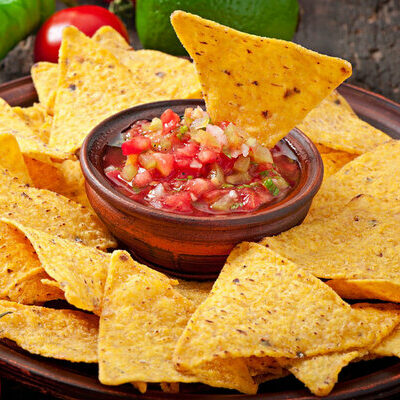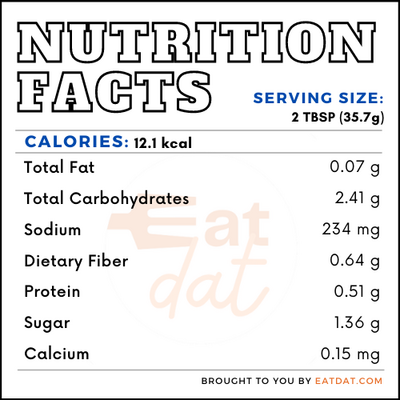
Salsa
What is Salsa?
Salsa is a condiment typically used in Mexican dishes. The word itself translates to sauce in Spanish. It may be chunky, smooth, or creamy, raw or cooked, and is used as a dip, sauce, or garnish. Outside Mexico, it mainly means a dip made from chopped tomatoes, chilies, and onions.
The most popular types of salsa are:
- Pico de Gallo
- Salsa Taquera
- Salsa Roja
- Salsa Verde
- Salsa de Aguacate
- Salsa Criolla
Origin of salsa
This dip was originally consumed by the Mayas, who made a raw salad of tomatoes, chilies, beans, and squash. Later on, the Aztec and Inca civilizations continued to make the dish, which was then documented for the first time by Spanish missionary Bernardino de Sahagun in 1592. It was named ‘salsa’ by Alonso de Molina, another Franciscan priest, after it became popular throughout Spain. The first commercial production of the condiment took place in Texas in 1948. This sauce continues to be eaten in almost the same way it was eaten thousands of years ago.
Nutrition
Nutritional profile for salsa (2 tbsp):

Salsa is rich in calcium, magnesium, phosphorous, potassium, sodium, vitamin A, carotene, lycopene, lutein + zeaxanthin, vitamin E, and vitamin K. The chili peppers in the sauce have multiple health benefits. Regular consumption of them may help in decreasing cholesterol and hypertension, increasing absorption of healthy fats (HDL) and satiety, as well as preventing diseases like diabetes, obesity, gastrointestinal diseases, and cardiovascular diseases. Also, they have antibacterial and anticancer properties, and may help in managing atherosclerosis and metabolic syndrome.
Tomatoes contain lycopene, which helps in reducing cardiovascular diseases, osteoporosis, and mental disorders through its anti-oxidative effects. In addition, lycopene has shown some alleviation of menopause symptoms. Regular consumption may increase vision health, regulate metabolism, and reduce the risk of certain cancers. Additionally, regular consumption of onions may help in reducing the risk of cancer, cataract, DNA damage, cardiovascular diseases. Both raw and cooked onions retain the flavanols and anthocyanin. However, the outer layers of the vegetable contain the most antioxidants.
Commercial production
Different types of this sauce are available commercially. The ingredients vary according to the variety and brand, but a the most common recipe includes tomatoes, chilies, jalapeño, vinegar, onions, garlic, and bell peppers. Spices are also added to the mix, including black pepper, cilantro, paprika, oregano, and cumin.
First, the tomatoes are peeled and all the impurities including seeds are discarded. All other ingredients are washed and cleaned. Then, the other ingredients are either pureed or diced, and mixed with the tomato. After that, the mixture is heated, and packaged into jars and vacuum sealed. Commercially produced salsa may include additives such as salt, sugar, vegetable oil, calcium chloride, pectin, modified food starch, xanthum gum, guar gum, dextrose, potassium sorbate, beet powder, canthaxanthin, sodium benzoate, and citric acid for increased shelf life.
Salsa recipes
This is usually used as a dip or condiment to be consumed with nachos, tortillas, enchiladas, and other traditional Mexican dishes. Also, it may be used to spice up a dish, including soups, rice, tacos, and other dishes. Here are a few recipes:
- Salsa
- Pico de Gallo
- Enchiladas Suizas
- Chilaquiles
- Tomatillo Sauce
- Chicken with Mexican Rice
- Queso
- Salsa Macha
- Fish Tacos
- Avocado Sauce
FDA regulations
The FDA classifies chilies under generally recognized as safe category. Also, it is classified as a spice. Tomatoes, onions, lime, and pineapple fall under the most frequently consumed raw vegetables and fruits.
References
Sanati, Setareh et al. “A review of the effects of Capsicum annuum L. and its constituent, capsaicin, in metabolic syndrome.” Iranian journal of basic medical sciences vol. 21,5 (2018): 439-448. doi:10.22038/IJBMS.2018.25200.6238, https://www.ncbi.nlm.nih.gov/pmc/articles/PMC6000222/
Hirose, Asuka et al. “Tomato juice intake increases resting energy expenditure and improves hypertriglyceridemia in middle-aged women: an open-label, single-arm study.” Nutrition journal vol. 14 34. 8 Apr. 2015, doi:10.1186/s12937-015-0021-4, https://www.ncbi.nlm.nih.gov/pmc/articles/PMC4406031/
Sidhu, Jiwan S et al. “Onion (Allium cepa L.) is potentially a good source of important antioxidants.” Journal of food science and technology vol. 56,4 (2019): 1811-1819. doi:10.1007/s13197-019-03625-9, https://www.ncbi.nlm.nih.gov/pmc/articles/PMC6443770/
